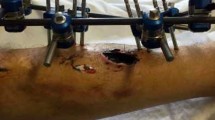Abstract
Seven hundred and four compound fractures —198 (28%) grade l, 259 (37%) grade ll, 247 (35%) grade 111 (86 IIIA, 119 11113, 42 IIIC) — were treated in 590 patients between May 1983 and May 1989 at the University of Louisville. Of these fractures, 157 (22%, group 1) received systemic antibiotic prophylaxis only, whereas 547 (78%, group 2) were treated with additional local application of aminoglycoside beads (tobramycin). Comparison of factors (fracture grades, age, sex, fracture location, follow up) revealed no significant differences between the two groups. All fractures underwent timely irrigation, debridement and skeletal stabilization. In group 1, 52 wounds were primarily closed, 53 underwent delayed primary closure and 52 were left open. In group 2 283 wounds were primarily closed, 229 were managed with the bead pouch technique and 35 were adapted loosely (delayed closure). Forty-nine (6.96%) of the 704 compound fractures became infected (acute wound infection and/or chronic osteomyelitis). Group 1 showed an infection rate of 16.6% (26/157), group 2 a rate of 4.2% (23/547). The difference was statistically highly significant (P < 0.001). Comparison of the infection rates, whether on an acute or a chronic basis, showed that infection rates were lower in group 2 than in group 1 for all fracture grades. A statistically significant difference was established only for type 11113 fractures, where the wound infection rate was 39.1 % (9/23) in group 1 and 7.3% (7/96) in group 2 (P < 0.001). The rate of chronic osteomyelitis was 26.1% (6/23) in group 1 and 6.3% (6/96) in group 2 (P < 0.025). Prophylactic use of antibiotic-bearing polymethylmethacrylate beads in addition to systemic antibiotics was of benefit in preventing infectious complications in compound fractures, in particular in type IIIB fractures.
Zusammenfassung
704 komplizierte Bruche [198 (28%) erstgradige, 259 (37%) zweitgradige, 247 (35%) drittgradige Bruche (Gustilo-Anderson-Klassifikation)] wurden zwischen Mai 1983 und Mai 1989 behandelt. Bei den Frakturen mit drittgradigem Weichteilschaden waren 86 IIIA-, 11911113- und 42 IIIC-Typen vorhanden (GustiloMendoza-Williams-Klassifikation). 157 offene Brüche (Gruppe 1) erhielten eine alleinige systemische Antibiotikagabe (Dreierkombination für 5 Tage), während in die Wunden von 547 komplizierten Frakturen (Gruppe 2) zusätzlich Aminoglykosid-PMMA-Ketten eingebracht wurden. Alle Frakturen wurden radikal debridiert, lavagiert und stabilisiert. Die Infektrate (akute Wundinfektion und/oder Osteomyelitis) betrug 16,6% in Gruppe 1 (26 von 157) und 4,2% in Gruppe 2 (23 von 547). Ein Vergleich der Infektionsraten zeigte eine Reduktion in Gruppe 2 gegeniiber Gruppe 1 bei alien Frakturgraden. Die Senkung der Infektionsrate war nur für den Frakturtyp 11113 statistisch significant: Die Wundinfektion betrug 39,1% in Gruppe 1 und 7,3% in Gruppe 2 (p < 0,001), die Osteomyelitisrate war 26,1 % in Gruppe 1 und 6,3 % in Gruppe 2 (p < 0,025). Der adjuvante lokale Antibiotikaeinsatz im Therapiekonzept offener Frakturen ist sinnvoll, insbesondere bei Brüchen vom Typ 11113.
Similar content being viewed by others
Literatur
Buchholz HW Gartmann HD (1972) Infektionsprophylaxe und operative Behandlung der schleichenden tiefen Infektion bei der totalen Endoprothese. Chirurg 43:446–453
Byrd HS, Spicer TE, Cierney G (1985) Management of open tibial fractures. Plast Reconstr Surg 76:719–728
Chapmann HW, Mahoney M (1979) The role of early internal fixation in the management of open fractures. Clin Orthop 138: 120–131
Fitzgerald RH Jr (1983) Experimental osteomyelitis: Description of a canine model and the role of depot administration of antibiotics in the prevention and treatment of sepsis. J Bone Joint Surg [Am] 65:371–379
Gustilo RB, Anderson JT (1976) Prevention of infection in the treatment of one-thousand and twenty-Eve open fractures of long bones. J Bone Joint Surg [Am] 58:453–458
Gustilo RB, Mendoza RM, Williams DN (1984) Problems in the management of type III (severe) open fractures. A new classification on type III open fractures. J Trauma 24:742–746
Gustilo RB, Gruninger RP, Davis T (1987) Classification of type III (severe) open fractures relative to treatment and result. Orthopedics 10:1781–1788
Gustilo RB, Merkow RL, Templeman D (1990) Current concept's review: The management of open fractures. J Bone Joint Sung [Am] 72:299–304
Henry SL, Ostermann PAW, Seligson D (1989) Prophylactic management of open fractures with the antibiotic bead pouch technique. J Orthop Trauma 3:157
Jensen WK, Johnsrud LW Nelson MC (1939) The local implantation of sulfanilamide in compound fractures. Surgery 6:1–15
Muhr G (1991) Therapeutische Strategic bei Frakturen mit Weichteilschaden. Chirurg 62:361–366
Ostermann PAW, Henry SL, Seligson D (1989) Behandlung von zweit- und drittgradig komplizierten Tibiaschaftfrakturen mit der PMMA-Kettentaschen-Technik. Unfallchirurg 92:523–530
Ostermann PAW, Ekkernkamp A, Henry SL, Seligson D (1992) Die Behandlung der offenen Fraktur vom Typ IIIB — Therapieregime und Ergebnisse. Zentralbl Chir 117:394–397
Patzakis MJ, Harvey JP, Ivler D (1974) The role of antibiotics in the management of open fractures. J Bone Joint Surg [Am] 56:532–541
Rodeheaver GT, Rukstalis D, Bono M (1983) A new model of bone infection used to evaluate the efficiency of antibiotic impregnated polymethylmethacrylate cement. Clin Orthop 178: 303–311
Trueta J (1940) Treatment of war wounds and fractures. Hoeher, New York
Author information
Authors and Affiliations
Rights and permissions
About this article
Cite this article
Ostermann, P.A.W., Henry, S.L. & Seligson, D. Der Nutzen einer adjuvanten lokalen Antibiotikagabe bei der Therapie offener Frakturen. Langenbecks Arch Chir 378, 32–36 (1993). https://doi.org/10.1007/BF00207992
Received:
Issue Date:
DOI: https://doi.org/10.1007/BF00207992




